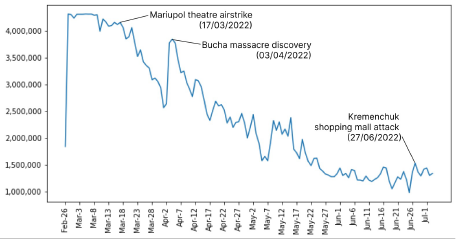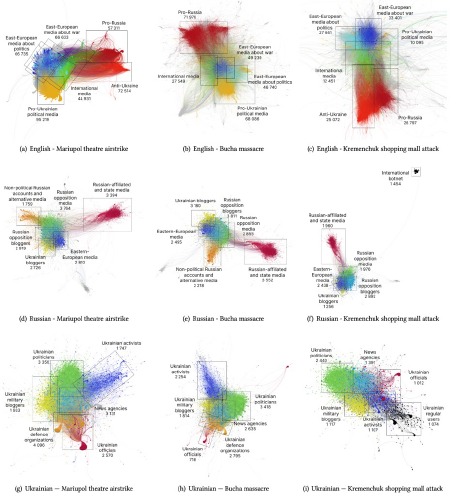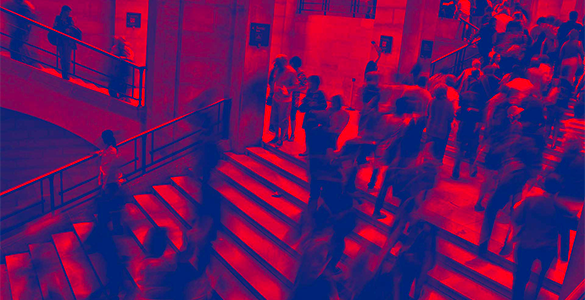Multilingual Narratives around the Russo-Ukrainian War Crises
-A TNA experience-
On February 24, 2022, the 8-year ongoing conflict between Russia and Ukraine commenced a major escalation, with Russia sending troops across the North and East borders of Ukraine. As military situation developed on the ground, a similar escalation took place in the war to control the narrative around the invasion in the mainstream and social media. This control is especially important, given that the billions of euros in support sent to Ukraine by the Western countries are often authorized by elected legislative bodies.
Attention around war events
In this work, carried out at the Universitat Pompeu Fabra with Fedor Vitiugin, a PhD student under the supervision of Dr. Carlos Castillo, explores the main actors in one of the largest social media websites, Twitter, in the battle over narratives around the Russo-Ukraine war. In particular, we focused on the Twitter discussions around three events: Mariupol theatre airstrike (17/03/2022), Bucha “massacre” discovery (03/04/2022), and Kremenchuk shopping mall attack (27/06/2022). To encompass a variety of views, we included English (in total 53M tweets), Ukrainian (1.7M), and Russian (2.4M) language posts. We found that the attention to the war was the highest within the first few weeks of the invasion, and decreased steadily after that (see Figure 1).

Figure 1. Number of tweets per day (all languages).
Stability of political communities
In each language, we build three networks in which a node is a user, and there is a directed edge between the nodes if one retweets another. Such retweet networks have been shown to capture agreement, or “endorsement”, between users posting on a topic [1]. In Figure 2 we show the communities discovered using the Louvain algorithm in these networks for the three languages, and three events. The communities in Russian networks are more disconnected than those in English and Ukrainian, likely due to the use of Russian language by those involved on both sides of the conflict. In all of the Russian networks, we find the Russian-affiliated and state media community to have few connections to the rest of the network. Throughout these events, the pro-Russia/anti-Ukraine clusters account for 32%, 27% and 38%, respectively, seemingly not diminishing in popularity by the third event.

Figure 2. User communities for each language and event (number of users) in retweet networks.
War-time narratives
Next, we explore the narratives of these communities using the narrative role framework [2]. Only one actor was present during all events and in all three languages was the Russian president Vladimir Putin, portrayed as a “villain” by the pro-West communities (but not pro-Russian ones). Similarly, The Ukrainian president Volodymyr Zelensky was portrayed as the principal persecutor (#ZelenskiWarCriminal) by the pro-Russian community. Whereas the pro-Russia communities prefered to write about more recent “heroes”, for example, pro-Russia German Russian blogger Alina Lipp and former UN weapon inspector Scott Ritter who criticized NATO, the others mentioned the Russian opposition leader Alexey Navalny with #freeNavalny during all three events. We find that the pro-Russian communities have a distinctly different foci in English and Russian. In English, the pro-Russia community mentions the Ukrainian Azov battalion, associating it with nazism – an ostensible reason Russia has cited for the invasion. In Russian, pro-Russia community shows an emotional arc throughout the three events: the first focuses on places involved in the war effort (in Ukraine, and also globally), the second besmirches the opposition (calling Ukrainians “ukraino-fascist”), and the last brings nostalgic nationalist feelings (around “history”, “monuments”, and “nostalgia”).
Collaboration for analyzing world events
Analysis performed in this study was greatly enriched by the perspectives of a diverse team that was assembled thanks to SoBigData++ TNA grant. Specifically, working with Fedor Vitiugin, a PhD student at the Universitat Pompeu Fabra allowed for a deep analysis of the culture-related narratives, especially those by users posting in Russian language. In a world where events often have international repercussions, cross-border collaboration is increasingly more important, and I would encourage further efforts such as SoBigData++ that may connect researchers around the world.
References:
[1] Kiran Garimella, Gianmarco De Francisci Morales, Aristides Gionis, and Michael Mathioudakis. 2018. Quantifying Controversy on Social Media. ACM Transactions on Social Computing 1, 1 (2018), 1–27.
[2] Constance de Saint Laurent, Vlad P Glăveanu, and Ioana Literat. 2021. Internet memes as partial stories: Identifying political narratives in coronavirus memes. Social Media+Society 7, 1 (2021), 2056305121988932.
Author:
Yelena Mejova, ISI Foundation, Turin, Italy
Exploratory:
Societal Debates and Misinformation
Sustainable Goal:
Goal 16: Peace, justice, and strong institutions

